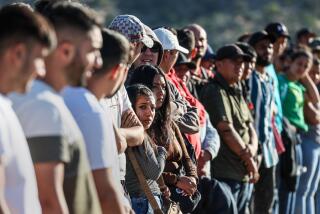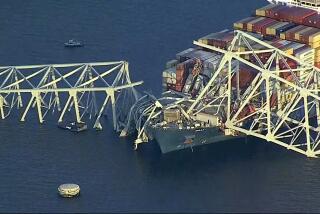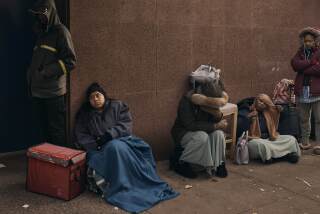Celebrating Immigration’s New Face
- Share via
NEW YORK — In a city forever celebrating itself, the story of Ellis Island has assumed heroic dimensions: More than 12 million immigrants poured into the harbor gateway near the Statue of Liberty. Many of these largely European newcomers played a huge role in the building of modern New York City and America itself.
“When you see Ellis Island, you wonder what so many people thought as they first glimpsed it, when they’d given up everything they know,” Mayor Michael R. Bloomberg said this week at City Hall, kicking off New York’s first Immigrant History Week. “And it makes you wonder how many of us here today would be as courageous.”
The new arrivals once came by boat, and their faces were German, Italian, Irish, Russian and Polish. But nowadays the new arrivals come by plane, and as a flood of immigrants from China, India, Pakistan, El Salvador, Mexico, West Africa, the Dominican Republic and other nations rush into the Big Apple, a new story is unfolding.
It is no less dramatic. But unlike the Ellis Island experience, which has been recounted in books, movies, plays and novels, the modern tale of people journeying to New York and the rest of the country is only now beginning to echo in American pop culture.
“The new version is still in flux, it’s still ongoing -- and that’s what makes it hard for a lot of people to grasp,” said Nancy Foner, author of “From Ellis Island to JFK: New York’s Two Great Waves of Immigration.”
“New York is changing every day as a result of this process, and everywhere you look -- on the subways, in neighborhoods, in parks, in taxis, on the streets -- you see the signs of something profound. But the new world is just beginning to be noticed.”
One reason is that Ellis Island continues to cast a long shadow. City officials have pointed out that Immigrant History Week observances are timed to remember April 17, 1907, when Ellis Island bureaucrats processed 11,747 immigrants -- the largest recorded number for one day in U.S. immigration annals. The processing facility, which was open from 1892 to 1954, reopened as a museum in 1990.
Yet the most recent wave of immigration to the city, which began in 1965, when the federal government loosened restrictions, has generated its own stunning statistics.
Nearly 1 million immigrants have settled in New York since 1990, and today 36% of city residents (or 2.9 million) are foreign-born, a figure rivaling the previous high of 41% reached in 1910, according to U.S. census statistics. The borough of Queens, where once-deteriorating neighborhoods have been revitalized by a flood of newcomers, is now thought to be the nation’s most ethnically diverse county.
The vast majority of arrivals are legal immigrants; an estimated 500,000 are considered undocumented. But their presence here is not nearly as controversial as it is in Southern California or other national regions, experts say, because the city has a long history of affirming the human and economic value of immigration.
“This is not to say that New York is an immigrant’s paradise,” Foner said. “It’s not like everyone in this city welcomes them, and they continue to experience various forms of discrimination. But they are here, and they have sparked major changes.”
Signs of these changes are just beginning to become a part of New York’s official story.
Less than a mile from City Hall, New Yorkers are packing the 45 Bleecker theater for “Bridge and Tunnel,” a one-woman show by playwright and actress Sarah Jones that re-creates a poetry slam in which 14 distinctive New York immigrant voices portray the pride and pain of a contemporary voyage to America.
Elsewhere, authors Warren Lehrer and Judith Sloan have chronicled the crazy-quilt diversity of New York immigrant life in “Crossing the BLVD,” a free-form book and multimedia presentation filled with oral histories that has won widespread praise. In it, Lehrer and Sloan celebrate the city’s rich ethnic stew. As one critic noted, they treat New York as “an enormous block party” where people are encouraged to meet their neighbors.
“The people you might meet on the New York subway have fascinating lives, and so many of them are new to America,” said Sloan. “They are truly the new face of this city, and people need to realize that. But this reality has been slow to catch on.”
At the Ellis Island Immigration Museum, which is run by the National Park Service, there are roomfuls of memorabilia and other exhibits telling the tales of people who came to America in the early 20th century. Yet visitors find only scant reference to the fact that most of the newcomers coming to New York since 1965 were not white-skinned.
“It’s all incredibly moving -- it’s a very brave story,” said Dave Martinez, a Santa Clarita resident who toured the museum this week with his wife, Mary. “But there are a lot of other stories that aren’t in there. I imagine they’d be fascinating too.”
Bloomberg’s City Hall event this week paid homage to the shift in immigration patterns. He gave a pop quiz, asking people to name the city’s five largest immigrant groups (Answer: Dominicans, Chinese, Jamaicans, Guyanese and Mexicans).
And he noted that in ZIP Code 11373 -- in Elmhurst, Queens -- more than 70% of the residents were foreign-born.
New York will acknowledge its vast legacy with ethnic festivals throughout the five boroughs. And the Ellis Island museum plans to complete a new wing within five years that will incorporate the story of New York’s most recent immigrant arrivals, according to librarian Barry Moreno.
But New Yorkers who know where to look can already sample the nuances of immigrant life, starting with “Bridge and Tunnel,” produced by actress Meryl Streep.
In a fictional Queens cafe near John F. Kennedy Airport -- where jets overhead reinforce the theme of New York’s immigrant arrivals -- the people who drive cabs, clean homes, work on construction sites and operate bodegas get a chance to sound off.
The cast of characters includes a Pakistani host who is hounded by immigration authorities; an embittered Mexican American who lost his wife as they journeyed to the United States; an indignant Jamaican woman launching her own show titled “I Am My Own Nanny”; a feisty Russian poet who deplores American literary tastes; and a tradition-bound Chinese mother coming to grips with her daughter’s lesbianism.
Gladys, the Jamaican, cracks that there are few jobs open for women of her ancestry: “One is to become secretary of State. Another is to take care of children. Either way it’s the same: You have to run behind an overprivileged baby who can barely form sentences, and clean up his messes while he takes a nap.”
A hip-hopper, who briefly hijacks the microphone at the slam, tells his immigrant audience: “Cause, knowwhattamsayin, like, aiight, black people, we got imported, y’all get deported, you feel me?” And the plucky moderator may be facing an FBI investigation, but insists he is “a red-blooded, Allah-fearing Republican.”
The lesson for New Yorkers is clear, said Palyn Hung, a public interest attorney who is familiar with immigrant legal issues and attended a performance this week.
“We all came from somewhere, and that’s as true for people who come to New York today as it was for people at Ellis Island,” she said. “It’s no less hard for them to adjust to a new world as it was so many years ago. We all take the same journey.”
More to Read
Sign up for Essential California
The most important California stories and recommendations in your inbox every morning.
You may occasionally receive promotional content from the Los Angeles Times.










